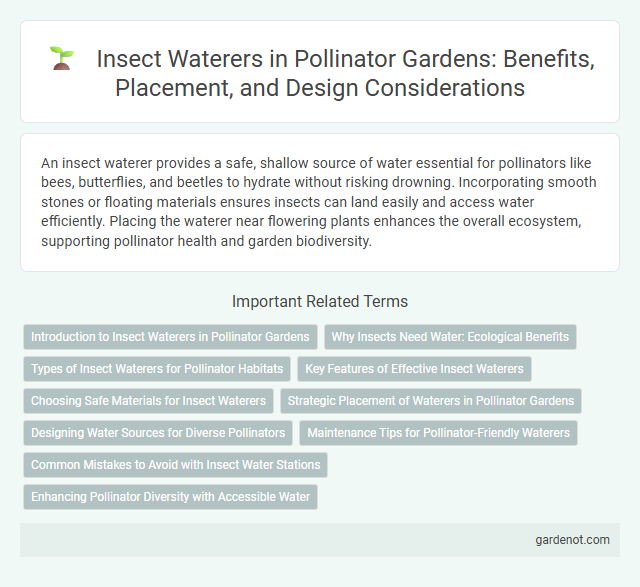An insect waterer provides a safe, shallow source of water essential for pollinators like bees, butterflies, and beetles to hydrate without risking drowning. Incorporating smooth stones or floating materials ensures insects can land easily and access water efficiently. Placing the waterer near flowering plants enhances the overall ecosystem, supporting pollinator health and garden biodiversity.
Introduction to Insect Waterers in Pollinator Gardens
Insect waterers provide essential hydration sources in pollinator gardens, supporting the survival of bees, butterflies, and other beneficial insects. These water features are specifically designed with shallow dishes or sponges to prevent drowning and ensure safe access to water. Integrating insect waterers increases pollinator activity and enhances overall garden biodiversity.
Why Insects Need Water: Ecological Benefits
Insects require water to maintain hydration, regulate body temperature, and support vital biological functions essential for their survival and pollination activities. Providing a reliable water source in a pollinator garden enhances insect health, promoting increased pollination efficiency and biodiversity. This contributes to a balanced ecosystem by sustaining populations of bees, butterflies, and other beneficial insects crucial for plant reproduction and agricultural productivity.
Types of Insect Waterers for Pollinator Habitats
Insect waterers designed for pollinator habitats include shallow dishes with smooth pebbles, small mud puddles, and specialized sponge setups to provide safe drinking spots. Floating platforms or shallow basins filled with marbles help prevent pollinator drowning by offering secure access to water. These variations ensure diverse species like bees, butterflies, and other beneficial insects have appropriate hydration sources within their natural environment.
Key Features of Effective Insect Waterers
Effective insect waterers feature shallow basins with varied surface textures, such as pebbles or moss, to provide safe landing spots for pollinators like bees and butterflies. These waterers maintain clean, pesticide-free water at a consistent, accessible level to prevent drowning and encourage regular hydration. Durable, weather-resistant materials ensure long-term outdoor use while minimizing maintenance requirements.
Choosing Safe Materials for Insect Waterers
Selecting safe materials for insect waterers is crucial to protect pollinators like bees and butterflies from harmful chemicals. Natural materials such as untreated wood, unglazed ceramic, and smooth stones provide safe surfaces and prevent drowning. Avoid plastics with toxic additives and metals that may leach contaminants into the water, ensuring a healthy environment for pollinators to hydrate.
Strategic Placement of Waterers in Pollinator Gardens
Strategic placement of insect waterers in pollinator gardens enhances accessibility and safety for pollinators, ensuring clean water sources near nectar-rich plants attract diverse species like bees, butterflies, and hoverflies. Positioning waterers in shaded, sheltered areas reduces evaporation and prevents overheating, while using shallow basins with pebbles or floating materials provides landing spots to minimize drowning risks. Consistent monitoring and refilling maintain hydration for pollinators, supporting their vital role in ecosystem pollination and garden health.
Designing Water Sources for Diverse Pollinators
Designing water sources for diverse pollinators requires shallow, accessible insect waterers with gentle slopes to accommodate various species like bees, butterflies, and beetles. Incorporating materials such as small pebbles or floating corks provides landing spots while preventing drowning risks. Consistent water availability in sunny, sheltered areas encourages frequent visits and supports pollinator hydration vital for ecosystem health.
Maintenance Tips for Pollinator-Friendly Waterers
Regularly clean insect waterers to prevent algae buildup and mosquito breeding, ensuring fresh, safe water for pollinators. Replace water every two days and use shallow dishes with pebbles or floating corks to provide landing spots for bees and butterflies. Position waterers in shaded areas to maintain cooler temperatures and avoid contamination from pesticides or debris.
Common Mistakes to Avoid with Insect Water Stations
Placing insect water stations in direct sunlight can cause water to overheat, deterring pollinators and potentially harming them. Using deep water containers without providing landing pads increases the risk of insect drowning, so shallow dishes with stones or floating objects are essential. Failing to regularly clean and refill insect waterers encourages algae growth and bacteria, which can spread disease among beneficial insects.
Enhancing Pollinator Diversity with Accessible Water
Insect waterers provide essential hydration points that significantly enhance pollinator diversity by offering accessible, safe water sources for bees, butterflies, and other beneficial insects. These water stations reduce the risk of pollinators drowning by incorporating shallow basins with landing surfaces like pebbles or mesh. Maintaining consistent, clean water supplies in pollinator gardens supports ecosystem health and boosts the reproductive success of various pollinating species.
Insect waterer Infographic

 gardenot.com
gardenot.com